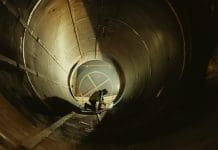The CITB has forecast growth in the construction sector will be reliant on the raft of planned infrastructure projects in the pipeline
A new report from the Construction Industry Training Board (CITB) has revealed infrastructure projects hold the key to industry growth.
According to the latest Construction Skills Network report it is expected the sector will grow just 1.7 per cent a year up to 2021. The organisation predicted a 2.5 per cent increase just 12 months ago.
Furthermore, recruitment is also expected to see lower figures than anticipated, with only 180,000 jobs estimated to be created, rather than the 232,000 predicted last January.
CITB’s chief executive Sarah Beale said: “While we are forecasting slower growth for our industry than we were last year, employers will still be creating tens of thousands of new jobs.
“We will be working with employers to attract new talent into our industry and to train them for rewarding careers in the sector.
“While we have factored Brexit into this forecast, there remain many unknowns to life after leaving the EU. We will be working with our industry to understand what it means for our migrant workforce and what we must do to attract and grow more of our own.”
Infrastructure projects hold the key
The CITB said it expects the sector to see growth during the period, but warned this would be reliant on large planned infrastructure projects going ahead and not experiencing any delays. If HS2, and the Hinkley Point C and Wylfa Newydd nuclear power plants go ahead these projects will make up 45 per cent of construction growth.
The report stated: “All predictions for the construction sector are made against a backdrop of ongoing political and economic uncertainty.
“The impact on the construction pipeline of Britain’s vote to leave the European Union is one of the most significant unknowns.
It added: “As wider economic turbulence can affect many parts of construction, the commitment to infrastructure is helpful to the forecast.
“But, with output growth so reliant on these major projects, any shifting of the goalposts on, for example HS2 or nuclear new build could be felt throughout the industry.
“If, for example, Hinkley was taken out of the pipeline, total construction output for 2021 would be 0.8 per cent lower than currently predicted. And the reliance on large infrastructure projects means that forecasts, particularly those made over the longer term, are less balanced than in the past.
“However, the changing of the guard at the top of government in the UK has, so far, not affected its commitment to the National Infrastructure Delivery Plan. The government is still pledged to invest over £100 billion in infrastructure by 2021.”
Regional construction growth
The construction sector in Wales will grow by 6.2 per cent a year due to work starting on Wyfla and the M4 upgrade. This figure is more than three times the national average.
England will also experience a good level of growth, with the capital increasing 2.4 per cent per year. The other regions across the country will also see a rise, with the South West forecast to grow 3.1 per cent, the North West 2.5 per cent, the South East 2.2 per cent, and the West Midlands by 1.3 per cent. Only the North East is expected to fall by -0.1 per cent.
However, Scotland is estimated to suffer a contraction in growth of 0.4 per cent. This is due to a number of major projects completing during this period.
The report said: “Profitability remains a concern, with the volatility of material and labour costs squeezing margins.
“The situation is not helped by deteriorating levels of productivity, and there is also the prospect of a potential gap in the labour market resulting from any changes to immigration policy.”
‘Defying economic headwinds’
CITB director of policy Steve Radley said: “We expect construction to keep defying the economic headwinds, with almost half of its growth coming from Hinkley, HS2 and Wylfa and other infrastructure projects.
“These huge projects give our industry a great chance to seize the initiative on skills and start investing in the next generation and upskilling the current one. So it’s vital that we don’t throw this opportunity away by allowing these projects to slip or get squeezed together and worsen the pressure on key skills.”













